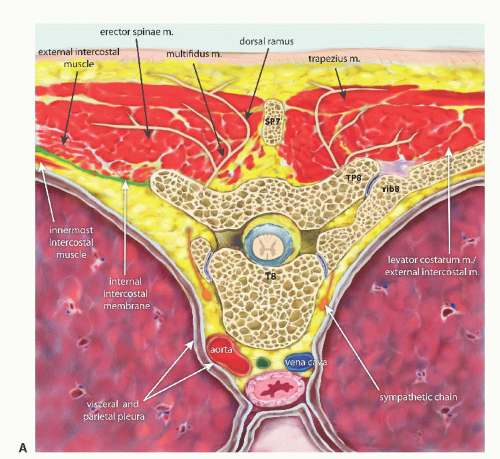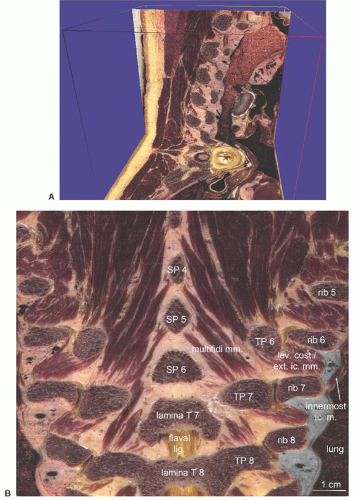Anatomy of the Paravertebral Space
Annelot Krediet
Nizar Maoyeri
Gerbrand J. Groen
Paul E. Bigeleisen
Thoracic paravertebral (TPV) blockade produces somatic and sympathetic blockade in adjacent unilateral dermatomes. It can be used to provide anesthesia and/or analgesia for a variety of surgical procedures in the thorax and abdomen and for treatment of painful conditions such as rib fractures.1 In recent years, a growing number of reports on ultrasound-guided TPV blocks have been published.2, 3, 4, 5, 6, 7, 8, 9and 10
Considering that ultrasound guidance has become a sTandard of care for peripheral nerve blockade, its application for TPV blockade is an attractive prospect. Whereas a traditional landmark-based technique is mainly dependent on the operator’s sense of touch, ultrasoundguided techniques offer additional information by visualizing the patient’s anatomy, the block needle trajectory, and local anesthetic spread. Previewing the intended insertion site can detect individual anatomical variation (e.g., scoliosis or osteophyte formation) and define the maximum safe depth for needle insertion. It is also valuable as a teaching tool for demonstrating the anatomy of the TPV space. However, these benefits are only Tangible if anatomical structures can be recognized quickly and reliably.
In this chapter, anatomical aspects relevant for ultrasonography of the TPV space are highlighted. Correlations between high-frequency ultrasound scans with high-resolution digitized anatomy are discussed in depth. This enables practitioners of regional anesthesia to appraise the spatial orientation of landmarks for TPV blockade on cross-sectional images that correspond to ultrasound images in clinical practice.
The anatomical images were obtained by slicing blocks of tissue from a human cadaver in transversal sections (interval: 78 µm) using a heavy-duty sledge cryomicrotome. The surface of each section was photographed at high resolution. Thousands of digitized photographs were thus obtained and then digitally stacked on top of each other using self-developed software to reconstruct the three orthogonal planes (sagittal, coronal, and transversal). The technique is described in detail elsewhere.11
Review of thoracic paravertebral (TPV) space anatomy
The TPV space is wedge-shaped.12 Figure 36.1 shows the TPV space in transverse, sagittal, and coronal cross sections at the level of T7. The base of the wedge is formed by the vertebral body, the intervertebral disk, and the intervertebral foramen medially. Laterally, the space tapers and proceeds as the intercostal space. The anterior boundary is formed by the parietal pleura (T2-T9/T10), the diaphragm (T9/T10-T12), and the mediastinum. Posteriorly, the transverse process, the superior costotransverse ligament (SCTL), and the paraspinal musculature confine the TPV space. The SCTL runs from the superior crest of
the neck of the rib toward the anterior-inferior surface of the transverse process superior to it. The TPV space is filled with adipose and loose connective tissue and furthermore contains the spinal nerve, the sympathetic trunk, and the intercostal vessels. It communicates with the epidural space medially, the intercostal space laterally, adjacent TPV spaces cranially and caudally, the prevertebral space anteriorly, and with adipose tissue posterior to the SCTL (Figs. 36.2 36.3, 36.4, 36.5 and 36.7).
the neck of the rib toward the anterior-inferior surface of the transverse process superior to it. The TPV space is filled with adipose and loose connective tissue and furthermore contains the spinal nerve, the sympathetic trunk, and the intercostal vessels. It communicates with the epidural space medially, the intercostal space laterally, adjacent TPV spaces cranially and caudally, the prevertebral space anteriorly, and with adipose tissue posterior to the SCTL (Figs. 36.2 36.3, 36.4, 36.5 and 36.7).
Anatomical Cross Sections: Transverse paravertebral space
Review of a series of consecutive transversal cross sections from cephalad to caudal illustrates the metamEric segmentation of the transverse paravertebral spaces. In Figure 36.2A and B, the vertebral body, the transverse process, and the rib are situated in the same transversal plane and confine the TPV space to a strip of adipose tissue anterior to the costovertebral joint. Inferior to the rib (Fig. 36.3A, right side of Fig. 36.3B and C), the transverse paravertebral space expands to a triangle between vertebral body, transverse process, and parietal pleura. Inferior to the transverse process, the transverse paravertebral space can be seen lateral and deep to the lamina (Fig. 36.4A, left side of Fig. 36.4B and C). The SCTL has an oblique orientation of 50 to 60 degrees to the skin in the transversal plane. The pleura runs almost parallel to the skin until it curves acutely to the mediastinum anteromedially (Fig. 36.3C).
 Figure 36.2. A: Cartoon of transverse section of paravertebral space showing rib and transverse process ribs. m., muscle; T8, eighth thoracic vertebral body; TP8,
Get Clinical Tree app for offline access

Full access? Get Clinical Tree


|






